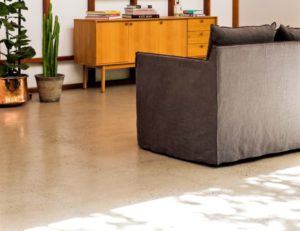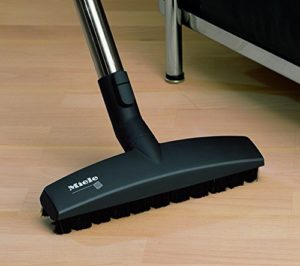
Floating floors are increasingly becoming the norm for a range of bare floor coverings in the US and Canada. Because it’s cheaper, faster, and easier to install floors in a floating fashion than through traditional stapling or nailing methods, the approach has become particularly prized among DIY-ers and home renovators.
What exactly is a floating floor?

It’s important to note that floating floors themselves aren’t a flooring type; it’s simply a term used to describe an installation technique. When you install a floor, whether laminate, vinyl, or engineered wood, as a floating floor, you connect each plank or board to its neighbor instead of to your subfloor. You can connect them either through interconnecting pieces that snap together or by simply gluing them to each other. However, as with every flooring technique and style, there are pros and cons to keep in mind. Today we’ll explore which floors can and cannot be installed in a floating method, why floating floors are safe and can be trusted not to move, and the overall pros and cons of floating floors.
Which kinds of floors can be installed as floating floors?

Laminate, vinyl, and engineered floors are the main kinds you’ll see installed as floating floors, with laminate being the most common example on the market. Let’s take a closer look at each.
Laminate floors are almost never glued to subflooring; instead, you’ll find it nearly exclusively installed in floating fashion. As a result, a laminate floor can follow humidity changes in a room and house by growing and shrinking. The pieces simply snap together, resulting in an installation simple enough for most homeowners to tackle.

Luxury vinyl floorboards are also designed to be glued to substrate, but they are more typically built to snap together; they include small tongues and grooves that lock one board to another with a bit of elbow grease.
The majority of engineered wood floors are stapled or nailed to plywood subflooring. However, you can purchase a growing number of brands, including Lock & Fold by Armstrong, that are installed without connection to the substrate.
Which floors can’t be installed in floating fashion?

While certain floors work well with floating installations, you can’t install them, generally speaking, with three types of floors: solid hardwood, porcelain and ceramic tile, and carpeting.
Solid hardwood is always installed through nails to whatever subfloor is present. If you want a genuine wood look while retaining floating floor flexibility, you might want to consider engineered wood as an alternative to hardwood.

Porcelain and ceramic tiles are almost always installed via mortar, which is essentially a permanent glue, that is connected to your substrate. There are a few floating tile examples on the market, including Soapstone. Instead of the traditional mortar approach, the tiles connect to each other through plastic trays that snap into each other. It’s effective, but it’s costly, and hasn’t caught on as a result.
Carpeting is the final common flooring that’s universally installed traditionally instead of through the floating approach. Even though carpet might look like a floating floor at first glance, a wall-to-wall carpet’s edges are always connected to a subfloor with tack strips. More broadly, only hard floor coverings may be installed as floating floors, not soft ones. An area rug is not a floating floor.
What are the pros and benefits of installing floating floors?

The main advantages of floating floors are price, ease of installation, and flexibility. Compared to traditional installations, it’s both cheaper and easier to install floating floors because they require less labor and are often possible to install without professional help.
As a quick example, if you want to nail or staple hardwood flooring, you’re going to need expertise and special tools. However, if you choose a laminate floor, you can install it as a floating floor by simply lining up the pieces and connecting them. In addition, a floating floor installation will give your floors room to expand and contract with increases and decreases in humidity.
What are the cons and drawbacks of floating floor setups?

However, not everything about floating floors is a net positive. You’re generally going to have thinner materials in your flooring compared to the materials that would have been used for a floor that was directly stapled or nailed to a subfloor.
Beyond the thinner materials, your flooring options for a floating floor installation will also be limited to generally lower quality materials, including vinyl, laminates, and engineered wood. You typically won’t get as much money when you sell your home from an investment in these floors as you would have from an investment in solid wood. However, if you aren’t counting on your floors as an investment and simply plan on using them for yourself and your family, this won’t factor into your considerations.
Which vacuums best clean and maintain floating floors?

The good news is that you don’t need particular vacuums to clean floors just because they’re installed as floating floors instead of through direct subfloor connection. That said, bare floors tend to do best with Parquet heads and carpeted floors benefit most from electric brush heads.

The reason we recommend Parquet heads for bare floors is because they’re more likely to suck up dirt and pet hair instead of simply pushing it around with suction; Parquet heads also polish most bare floors while cleaning them due to the soft brushes. Electric powered brush heads, in contrast, have the strength necessary to pull dirt and fur from carpets, where more power is essential to remove them from the fibers in which they’re embedded. Two vacuums that Miele Complete C3 Cat & Dog (reviewed here and here) and Miele Compact C2 Electro+ (reviewed here and here).
![]() You can buy the Miele Complete C3 Cat & Dog here on Amazon or buy the Miele Compact C2 Electro+ here.
You can buy the Miele Complete C3 Cat & Dog here on Amazon or buy the Miele Compact C2 Electro+ here.
![]() Canadians can buy the Miele C3 Cat & Dog here or buy the Compact Electro+ here.
Canadians can buy the Miele C3 Cat & Dog here or buy the Compact Electro+ here.
 If you find our research on PMC helpful, you can follow our efforts to keep maniacally reviewing home cleaning tools by shopping through our links above. We promise to keep fighting the good fight against every horror children, animals, and grown, yet messy humans can inflict upon a clean home.
If you find our research on PMC helpful, you can follow our efforts to keep maniacally reviewing home cleaning tools by shopping through our links above. We promise to keep fighting the good fight against every horror children, animals, and grown, yet messy humans can inflict upon a clean home.

